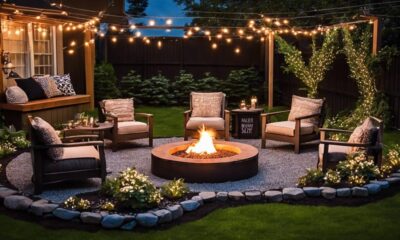Retreat
DIY Retreat Center Merchandise: Creating and Selling Branded Items
Join the journey of crafting unique branded merchandise for your DIY retreat center, and discover how it can elevate your community and identity.
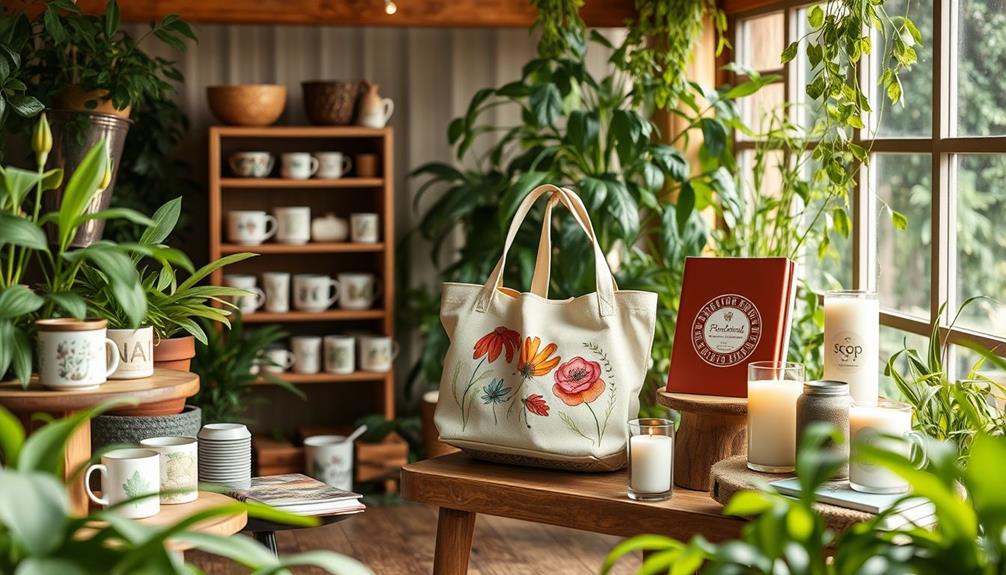
Creating and selling branded merchandise for your DIY retreat center can strengthen your identity and foster community. Start by defining your brand with a memorable logo, cohesive colors, and emotional messaging that resonates. Design unique products using eco-friendly materials, focusing on quality and local collaboration. Use social media and an online store to effectively market your items, while engaging your audience through workshops and community events. Sustainable practices, like a made-to-order model and biodegradable packaging, will resonate with your environmentally conscious clientele. Stick around to uncover more strategies for boosting your retreat's success through effective merchandise.
Key Takeaways
- Develop a cohesive brand identity with a unique logo and color palette to differentiate your merchandise.
- Choose eco-friendly materials and quality production methods for sustainable and appealing products.
- Offer a diverse range of items, including apparel and wellness tools, collaborating with local artisans for uniqueness.
- Utilize social media and email marketing to promote your merchandise, highlighting new products and exclusive discounts.
- Engage the community through workshops and events, fostering a sense of belonging and encouraging support for your merchandise.
Defining Your Brand Identity
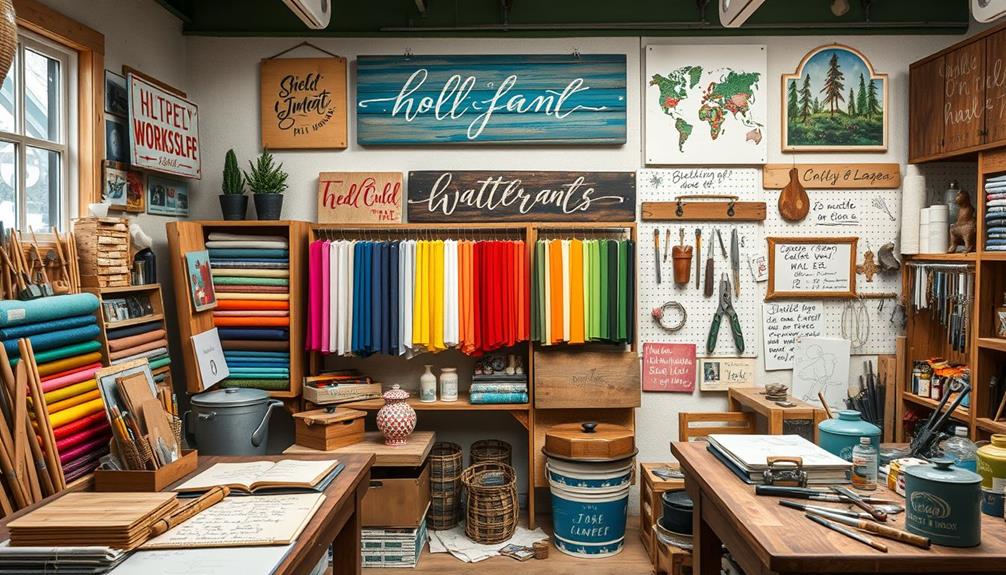
When it comes to defining your brand identity, clarity and consistency are key. A strong brand identity sets your DIY retreat center apart from competitors, helping you foster recognition and trust among potential attendees.
Start by establishing consistent visual elements, like a unique logo and a cohesive color palette. These components enhance brand recognition and create a memorable impression. Additionally, consider how content quality and topical authority can contribute to your brand's credibility and trustworthiness.
Next, focus on crafting clear, emotional messaging that resonates with your target audience. This deeper connection not only encourages attendance but also promotes word-of-mouth marketing.
Consider incorporating unique elements related to your retreat experiences into your branding; this can create a sense of exclusivity that appeals to your audience.
To guarantee your brand identity remains intact across various platforms, develop thorough brand guidelines. These guidelines will help maintain consistent branding in all marketing materials and merchandise, reinforcing your retreat center's identity.
Designing Unique Merchandise
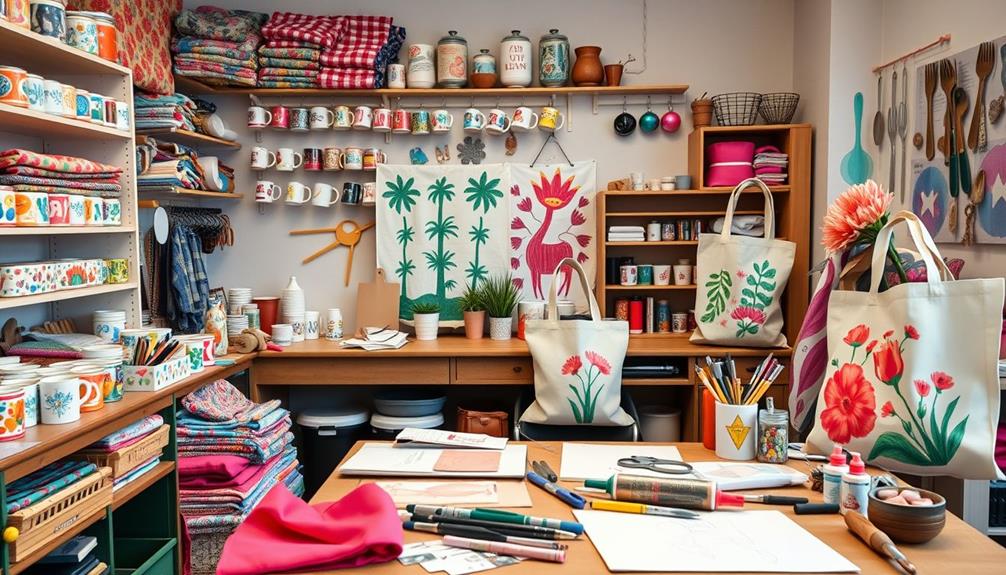
As you commence designing unique merchandise for your DIY retreat center, it's essential to incorporate your brand identity into every aspect of your products. Use logos, colors, and messaging that reflect your retreat's essence, enhancing recognition and fostering an emotional connection with your audience.
Consider emphasizing natural materials and eco-friendly choices, as seen in the modern farmhouse decor trends, to align with current consumer preferences.
Focus on quality by selecting high-grade materials and production methods. This guarantees durability and satisfies customers, creating positive associations with their retreat experience.
Additionally, offer a diverse range of merchandise, including apparel, eco-friendly items, wellness tools, and souvenirs. This variety caters to different attendee preferences and boosts your sales potential.
To elevate your offerings, consider collaborating with local artisans. Their unique, handcrafted items resonate with your retreat's theme and promote authenticity while supporting the local economy.
Don't forget to leverage customer feedback. Actively solicit input from attendees about their desired merchandise types and designs. This not only allows for continuous improvement but also aligns your products with audience interests.
Marketing Your Products
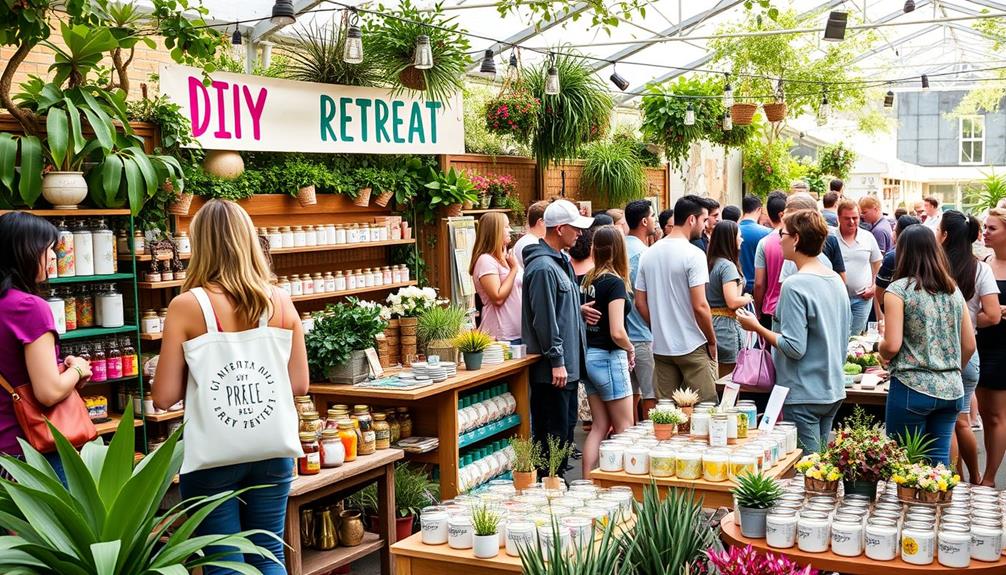
Creating unique merchandise is just the beginning; effectively marketing your products is what'll truly drive sales and brand loyalty. To reach your target market, leverage social media platforms. Showcase your merchandise with visually appealing posts, engaging stories, and influencer collaborations to boost visibility and attract potential buyers.
Consider also exploring best websites to earn money online to find additional platforms for promoting your merchandise.
Setting up an online store on your retreat center's website or using e-commerce platforms like Etsy or Shopify will streamline the purchasing process and help you reach a broader audience. Implementing email marketing campaigns is another powerful strategy; promote new products, exclusive discounts, and limited-time offers to encourage repeat purchases and foster customer loyalty.
Don't forget the importance of in-person engagement. Attend local wellness fairs or community events to showcase your merchandise directly to your target audience, creating immediate sales opportunities.
Additionally, utilize customer feedback and testimonials in your marketing materials to build credibility and trust. By incorporating these marketing strategies, you'll create relevant content that resonates with your audience, turning casual browsers into loyal customers.
Sustainable Production Practices
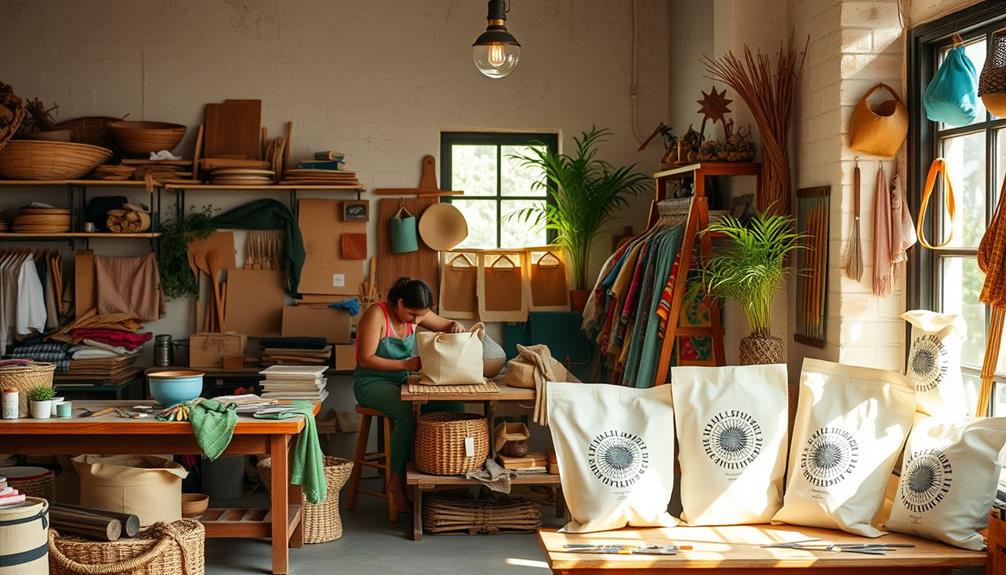
Sustainable production practices are essential for any retreat center looking to make a positive impact on the environment while appealing to eco-conscious consumers. By sourcing eco-friendly materials like organic cotton or recycled plastics, you can greatly reduce the environmental footprint of your merchandise.
Implementing a "made-to-order" model allows you to minimize waste by producing items only after a purchase is made, avoiding overproduction and excess inventory. Additionally, you can consider incorporating unique offerings that resonate with customers, similar to how coffee entrepreneurs build brands around quality and community engagement unique offerings in coffee.
Utilizing local artisans and manufacturers not only supports the local economy but also cuts down on transportation emissions, making your products even more sustainable.
When it comes to packaging, adopting biodegradable options like compostable mailers or recycled paper guarantees that your merchandise packaging doesn't contribute to landfill waste.
Moreover, engaging in transparency about your supply chain will provide customers with insight into your sustainable production practices. This openness can enhance brand loyalty and attract eco-conscious consumers who value ethical purchasing decisions.
Engaging With Your Community
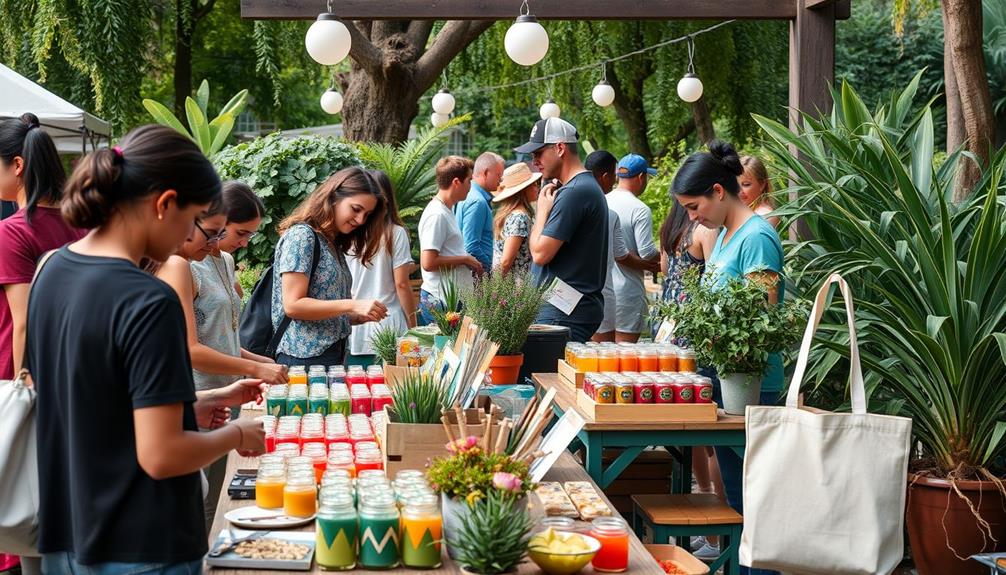
Many retreat centers overlook the power of community engagement, yet it can be the cornerstone of your success. By actively engaging with your community, you foster a sense of belonging that encourages local support and participation in your retreat center's offerings.
Understanding the importance of a budget when planning community events can also enhance your outreach efforts. Hosting workshops and open houses allows potential attendees to experience your atmosphere and values firsthand, nurturing relationships before they even arrive.
Utilizing social media is essential in sharing stories, testimonials, and behind-the-scenes content. This connection makes your audience feel involved in your journey, increasing the likelihood they'll support your branded merchandise.
Consider collaborating with local artists or businesses to create unique products that reflect local culture and values, strengthening those community ties.
Additionally, implementing a referral program rewards community members for bringing in new attendees, incentivizing participation and creating a supportive network around your retreat center.
When you engage with your community, you not only enhance attendance but also increase word-of-mouth referrals. By investing time and effort into these relationships, you'll build a thriving environment that benefits both your retreat center and the community at large.
Frequently Asked Questions
Is Owning a Retreat Center Profitable?
Yes, owning a retreat center can be profitable. With careful management, strategic marketing, and diverse offerings, you can tap into the growing wellness market and achieve impressive revenue while attracting loyal customers.
How to Start a Spiritual Retreat Business?
To start a spiritual retreat business, you'll want to identify your niche, conduct market research, choose an ideal location, draft a solid business plan, and guarantee you meet all legal requirements. It's an exciting journey!
How Do I Create a Retreat Program?
To create a retreat program, you'll identify your core purpose, mix workshops and experiential activities, collaborate with skilled facilitators, gather participant feedback, and design a balanced schedule for both structured engagement and relaxation.
How to Market a Spiritual Retreat?
To market your spiritual retreat, leverage social media for engaging content, collaborate with influencers, offer early bird discounts, host free webinars, and share testimonials. These strategies will attract attendees and enhance your retreat's visibility.
Conclusion
Just as a seed grows into a vibrant tree, your retreat center's merchandise can blossom into a brand that resonates with your community. By nurturing your identity, crafting unique items, and engaging in sustainable practices, you cultivate a connection that thrives. Remember, every piece you create is like a leaf, contributing to the whole. So, plant your vision, water it with creativity, and watch as your brand flourishes, bringing joy and purpose to all who encounter it.
- About the Author
- Latest Posts
Introducing Ron, the home decor aficionado at ByRetreat, whose passion for creating beautiful and inviting spaces is at the heart of his work. With his deep knowledge of home decor and his innate sense of style, Ron brings a wealth of expertise and a keen eye for detail to the ByRetreat team.
Ron’s love for home decor goes beyond aesthetics; he understands that our surroundings play a significant role in our overall well-being and productivity. With this in mind, Ron is dedicated to transforming remote workspaces into havens of comfort, functionality, and beauty.
Retreat
How to Design and Build a Sweat Lodge for Your Retreat Center
Open the door to creating a transformative sweat lodge for your retreat center and discover the essential steps to make it a sacred space.
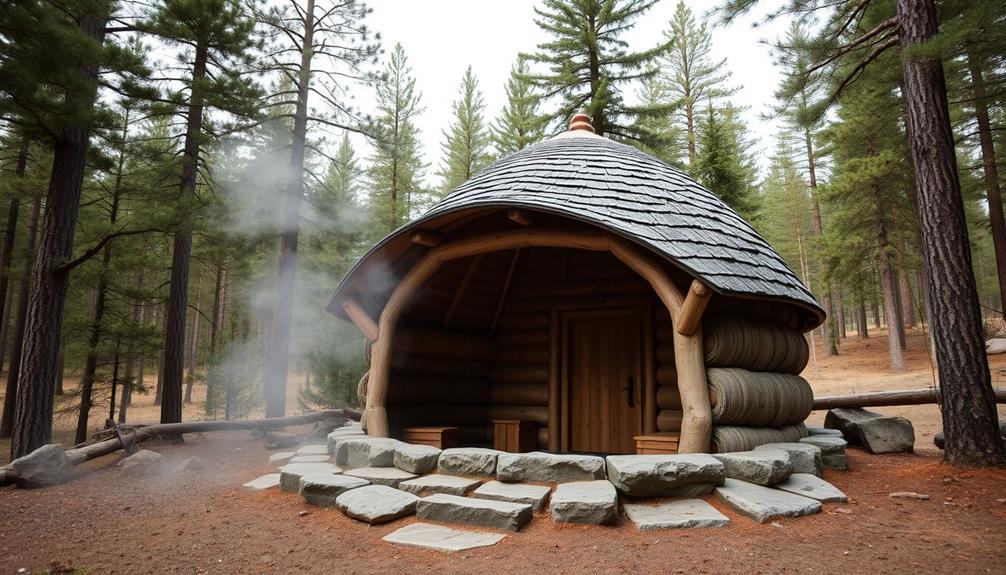
To design and build a sweat lodge for your retreat center, start by selecting a flat, tranquil site near water. Use willow saplings for the structure and cover it with wool blankets and untreated canvas. Gather about twenty-eight dense igneous stones for heating. Create a dome shape by bending the poles inward and secure everything tightly. Ascertain the lodge faces east for symbolic reasons, and prepare the interior for ceremonies with proper heating and steam generation. This sacred space enhances emotional and spiritual healing, and there's much more you can explore to make your sweat lodge truly unique and impactful.
Key Takeaways
- Select a flat, fire-safe location near water, ideally with beautiful surroundings for a deeper connection to nature.
- Construct the mainframe with long, soaked willow saplings, forming a strong dome shape for stability.
- Use natural materials like wool blankets and untreated canvas for insulation, avoiding synthetic options.
- Gather and heat approximately twenty-eight dense igneous stones to create steam during the ceremony.
- Honor the cultural significance by involving participants in offerings and traditional practices to enrich the experience.
Materials for Construction

When constructing a sweat lodge, you'll want to choose the right materials to guarantee safety and effectiveness. Start with long, straight willow saplings about one inch in diameter for the mainframe. Smaller poles work well for tying the structure together.
It's crucial to cover the lodge with natural materials like wool blankets and untreated canvas. For a touch of creativity in the environment, you might consider incorporating unique aesthetics similar to unique and wicked planters that enhance the overall experience. Avoid synthetic materials to prevent harmful off-gassing when the heat rises.
For the heat source, you'll need around twenty-eight igneous rocks, preferably dense lava rocks. These "Grandfathers" should be free from air or water pockets to prevent hazards when heated. Arrange them in a horseshoe ring to create structural integrity, ensuring the dome shape remains secure.
The circular design typically measures 4-5 feet in diameter, comfortably accommodating 6-10 participants. Always remember to orient the lodge facing east. This orientation not only enhances the spiritual experience but also allows for maximum heat retention.
Site Selection and Preparation

When selecting a site for your sweat lodge, pick a flat area with minimal ground and ladder fuels to guarantee safety.
Consider choosing a location that offers stunning landscapes and tranquility, similar to New England camping locations, which can enhance your connection to nature.
Clear the space to comfortably fit 6-8 participants, and measure out a circular area about 4-5 feet in diameter for the lodge's layout.
Don't forget to orient the doorway to the east to symbolize renewal and enhance your connection to nature.
Ideal Location Criteria
Selecting the right location for your sweat lodge is essential to creating a meaningful and safe experience. Start by identifying a flat area that's clear of ground and ladder fuels. This minimizes fire hazards and guarantees safety when the ceremony begins.
Additionally, consider the long-term strategy of your retreat center, as a well-chosen location can enhance the overall experience and attract more participants, similar to the importance of setting savings goals in personal finance. Look for a site that's close to a water source, making it easy to access water for pouring over heated stones during the ceremony.
You'll also want to choose a spot with minimal foot traffic and distractions. This helps maintain the sacredness and focus of the sweat lodge experience. An ideal location criteria includes orienting the doorway of the lodge to the east. This honors the rising sun, symbolizing new beginnings and spiritual renewal.
Lastly, prepare the ground by clearing a space that accommodates the lodge's planned size, typically 4-5 feet in diameter. This guarantees a comfortable fit for participants and allows for an intimate atmosphere.
Ground Preparation Techniques
Thorough ground preparation is essential for setting up your sweat lodge effectively. Start by selecting a flat area that's fire-ready and free from excess ground and ladder fuels. This minimizes fire hazards during your ceremonies.
Once you've chosen your site, clearing away debris and vegetation not only creates a spacious environment, accommodating 6-10 participants within a 4-5 feet diameter circle, but also enhances the overall ambiance, much like how different brewing methods can affect the coffee experience.
Next, utilize ground preparation techniques to accurately mark the circular layout of the lodge. Use a spike and cordage to guarantee proper geometry, which is vital for structural integrity during construction.
After marking, dig a depression in the ground for the heated stones. This allows for effective heat distribution, guaranteeing a comfortable experience for everyone inside.
Lodge Structure Design
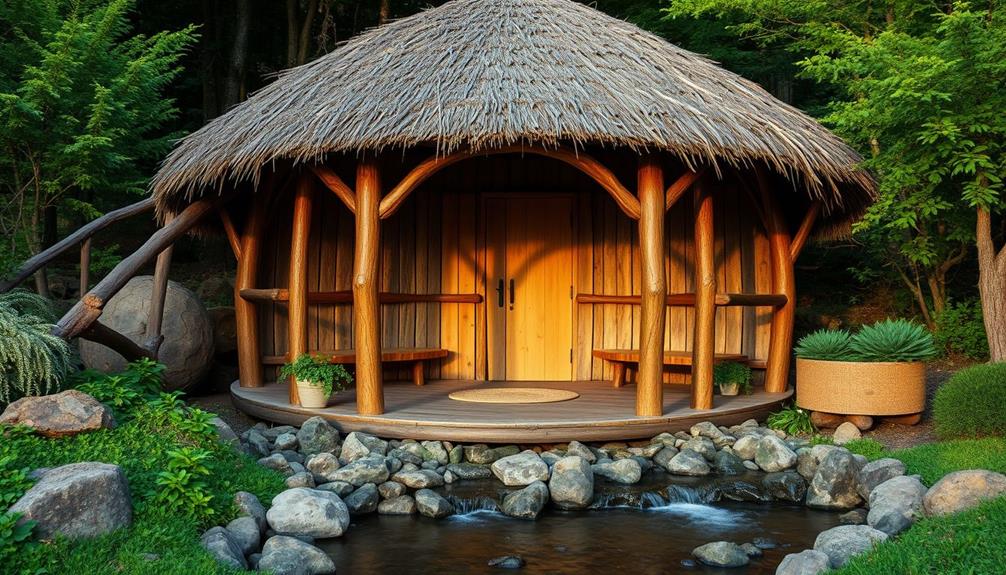
A well-constructed sweat lodge is vital for a successful retreat experience. Begin by selecting a flat, fire-ready area with minimal ground fuels, ensuring you have enough space for 6-8 participants inside the lodge. Aim for a 4-5 foot diameter circle. For the mainframe, use long, straight willow poles—harvesting around twelve mainframe poles and a dozen smaller ones. Soak them for flexibility during construction.
Bend the poles inward to create a strong dome shape, tying them together securely and adding ribbing for extra stability. It's important to dig a depression inside the lodge for heated stones and orient the doorway to the east, aligning with traditional practices. Finally, tamp the poles firmly into the ground and follow a geometric configuration to enhance the lodge's structural integrity.
Here's a quick overview of the key elements:
| Element | Description |
|---|---|
| Pole Selection | Use long, soaked willow poles |
| Shape | Strong dome structure with ribbing |
| Orientation | Doorway facing east, depression inside |
Covering the Sweat Lodge
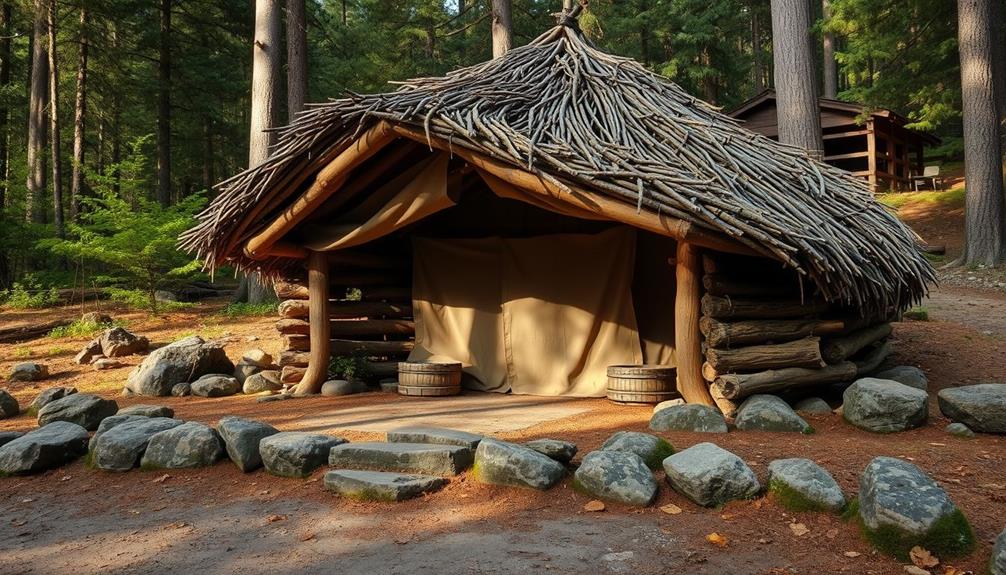
When covering your sweat lodge, stick to natural materials like wool blankets and untreated canvas to prevent harmful off-gassing.
Using materials that are free from chemicals is vital for maintaining a healthy environment, similar to how certain essential oils for respiratory health can support overall wellness.
Aim for about eight wool blankets and three canvas sheets to guarantee proper insulation and heat retention.
Natural Covering Materials
Covering your sweat lodge with natural materials is vital for creating an effective and safe environment. Using wool blankets and untreated canvas is preferable because they provide excellent insulation and don't release harmful toxins when heated.
Historically, animal hides or buffalo robes were common, but today, you'll often find eight wool blankets combined with three canvas sheets to effectively maintain heat within the lodge. Additionally, incorporating natural essential oils for relaxation can enhance the overall experience, promoting serenity and deeper connection during the ceremony.
It's important to steer clear of synthetic materials in your covering process. These materials can release toxins when exposed to the high temperatures of the ceremony, compromising both safety and the experience.
Proper insulation using natural materials guarantees a conducive atmosphere for the ceremony, enhancing participants' spiritual and emotional experiences by retaining heat and steam.
When layering your covering materials, be mindful of creating a strong, insulated dome shape. This careful arrangement not only facilitates effective heat retention but also supports the deeper benefits of the sweat lodge experience.
Insulation Techniques and Considerations
Maintaining heat inside the sweat lodge relies heavily on effective insulation techniques. Start by choosing natural materials like wool blankets and untreated canvas. These materials prevent off-gassing during heating, unlike synthetic options that can release harmful chemicals.
You'll need about eight wool blankets and three canvas sheets to guarantee proper insulation and heat retention, creating a cozy atmosphere for participants. Incorporating elements of traditional Hopi practices can further enhance the spiritual connection to the land, which is an essential aspect of the sweat lodge experience.
Incorporating traditional coverings, such as animal hides or buffalo robes, can enhance the authenticity of the experience while adding extra thermal insulation. When applying these insulation techniques, pay close attention to securing the coverings; any gaps can lead to significant heat loss during the ceremony.
Flexible, well-fitted materials contribute to the structural integrity of the lodge, guaranteeing effective heat retention. This attention to detail will keep your participants comfortable throughout the session.
Your original work in designing the sweat lodge will ultimately depend on how well you implement these insulation considerations. By prioritizing natural, secure, and traditional materials, you'll create an inviting and warm environment that honors the spirit of the sweat lodge experience.
Heating Stones and Ceremony
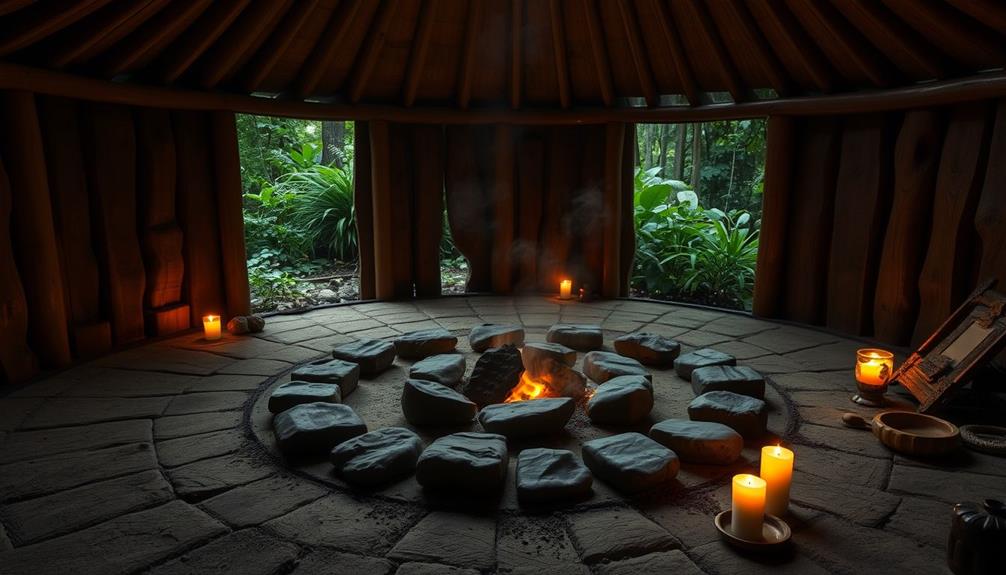
Heating stones play an essential role in the sweat lodge ceremony, creating an environment that fosters both physical cleansing and spiritual renewal. To prepare, gather approximately twenty-eight dense igneous rocks, preferably lava rocks, which excel in heat retention.
Before the ceremony, heat these stones for a couple of hours until they glow red-hot, ensuring they're safe—avoid stones with air or water pockets, as they can explode when heated. For those looking to enhance their overall experience, incorporating techniques from primitive weapons for modern survival can deepen one's connection to the natural world during the ceremony.
During the ceremony, you'll use about 12-13 heated stones to maintain effective heating within the lodge. Participants pour water over these stones using a metal bucket and ladle, generating steam that enhances the cleansing experience. This ritual not only purifies the body but also elevates the spiritual atmosphere.
Before entering the lodge, perform saging to cleanse and prepare the space. This fosters a respectful environment for the ceremony, allowing participants to connect deeply with the experience.
Spiritual and Emotional Benefits
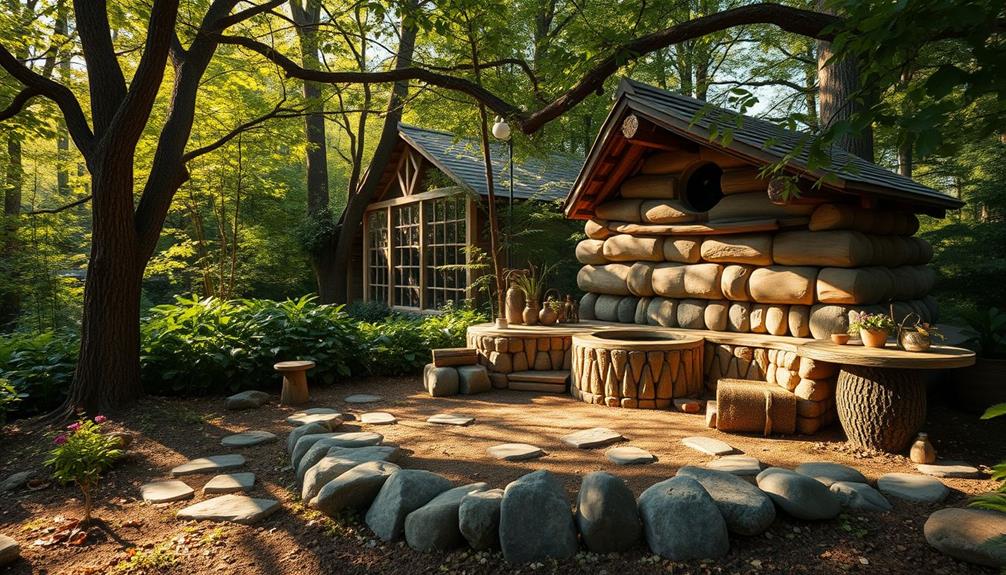
Stepping into a sweat lodge opens the door to profound spiritual and emotional benefits that can transform your experience. This sacred space encourages the purification of your mind, body, spirit, and soul through traditional practices. As you participate in the ceremony, you may find yourself on a journey of emotional healing, gaining insights that foster personal growth and a deeper understanding of cultural practices. The experience is further enriched by heartfelt expressions of love, creating an atmosphere where emotional connections can flourish.
Within the lodge, the atmosphere of trust and confidentiality allows you to express your personal concerns freely. This environment nurtures spiritual peace, as shared rituals create bonds among participants, reinforcing a sense of community and support. You're not just engaging in a ceremony; you're entering a collective experience that promotes reflection and connection.
After the sweat lodge session, communal activities like feasting on fresh berries further enhance your emotional well-being, solidifying the connections made. These moments not only elevate your spirit but also enrich your sense of belonging.
Ultimately, the spiritual and emotional benefits you gain from the sweat lodge experience can lead to a transformative journey, deepening your understanding of yourself and your place within a supportive community.
Cultural Significance and Traditions

The cultural significance of sweat lodges runs deep within Native American traditions, where they serve as sacred spaces for prayer and connection to ancestral spirits, often referred to as the Grandfathers. These structures aren't just physical spaces; they embody a profound respect for the land and natural elements, highlighting the cyclical nature of life.
As you design your sweat lodge, consider the seasonal changes that influence the rituals, aligning your practices with these essential life cycles. Additionally, creating a supportive environment is important, as participants may experience intense emotions reminiscent of those seen in individuals with emotional dysregulation, which can be common in various contexts, including traditional ceremonies.
Elders play a significant role during sweat lodge ceremonies, guiding participants and ensuring that the integrity of the experience is maintained. Their wisdom and connection to traditions enrich the ceremony, making it more meaningful.
Participants often bring offerings like tobacco and food to honor the spirits, fostering a sense of community and reinforcing shared cultural values.
Frequently Asked Questions
What Is the Best Material for a Sweat Lodge?
The best materials for a sweat lodge are willow saplings for structure, lava rocks for heating, and natural coverings like wool blankets or untreated canvas. Avoid synthetic materials to guarantee safety during your ceremony.
What Are the 4 Rounds of Sweat Lodge?
You might think each round's just a ritual, but they're transformative. In the sweat lodge, you honor the Grandfathers, Grandmothers, set intentions, and celebrate connections, fostering community and personal growth through shared prayers and songs.
How Many Willows to Make a Sweat Lodge?
You'll need around twelve mainframe willow poles and a dozen smaller ones for tying. Depending on your lodge size, adjust the number of poles to comfortably fit about ten participants during the experience.
How Many Stones Are in a Sweat Lodge?
In a typical sweat lodge, you'll need about twelve to thirteen heat-absorbent stones, called Grandfathers. For larger lodges, consider using up to twenty-eight stones to guarantee a warm, effective environment for participants.
Conclusion
Building a sweat lodge for your retreat center can be a transformative experience for both you and your visitors. Remember, "what you give is what you get." By carefully selecting materials, designing the structure, and honoring the cultural significance, you create a sacred space that promotes healing and connection. Embrace the journey, and let the sweat lodge become a powerful tool for spiritual and emotional growth in your community. Your efforts will resonate long after the last stone is heated.
- About the Author
- Latest Posts
Introducing Ron, the home decor aficionado at ByRetreat, whose passion for creating beautiful and inviting spaces is at the heart of his work. With his deep knowledge of home decor and his innate sense of style, Ron brings a wealth of expertise and a keen eye for detail to the ByRetreat team.
Ron’s love for home decor goes beyond aesthetics; he understands that our surroundings play a significant role in our overall well-being and productivity. With this in mind, Ron is dedicated to transforming remote workspaces into havens of comfort, functionality, and beauty.
Retreat
The Role of Art in Retreat Center Design and Atmosphere
Navigating the intersection of art and retreat design reveals transformative experiences that foster connection and creativity—discover how it shapes your next getaway.

Art plays a crucial role in shaping the design and atmosphere of retreat centers. It enhances your experience by infusing creativity and fostering connection. You'll find that local artwork creates a sense of place while natural elements inspire creativity and well-being. Collaborative spaces encourage dialogue and shared artistic pursuits, helping build community. Additionally, art installations reflect the local culture, enriching your retreat with unique identities. By blending innovative design and sustainable practices, these centers cultivate environments that promote personal growth and mindfulness. Keep exploring to uncover how art transforms retreats into transformative experiences.
Key Takeaways
- Art enhances the retreat experience by fostering creativity, mindfulness, and personal growth in participants.
- Incorporating local artwork creates a cultural connection and transforms spaces into inviting, inspiring environments.
- Collaborative artistic spaces facilitate networking and community building, enriching the overall retreat atmosphere.
- Natural surroundings and innovative installations stimulate artistic expression and promote psychological well-being among attendees.
- Accessibility considerations in design ensure inclusive participation and engagement for diverse artistic practices and backgrounds.
Importance of Art in Retreats
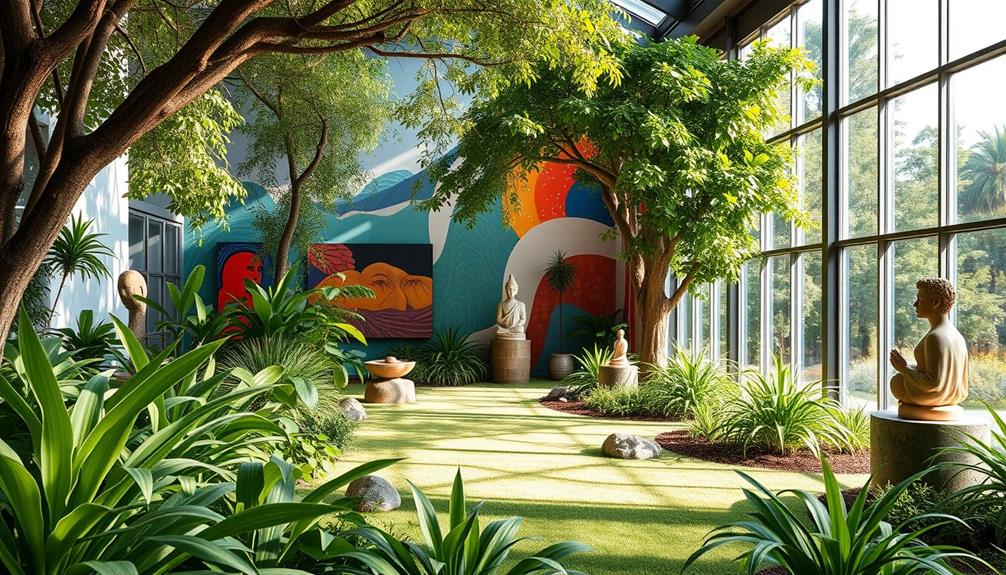
Art's presence in retreat centers greatly enhances the overall experience for participants. When you immerse yourself in a space filled with creativity, inspiration flows more freely. Incorporating art into retreat designs fosters environments where artists can engage deeply with their practices. These serene settings stimulate artistic exploration, allowing you to access your full potential.
Additionally, many spiritual retreats in the U.S. increasingly emphasize the integration of art and mindfulness, creating a holistic approach to personal growth and wellness increasing interest in wellness tourism.
Workshops and activities centered around art encourage collaboration, boosting productivity and clarity in your artistic vision. You'll find that sharing ideas with fellow artists creates a vibrant community that enriches your experience. The beauty of art not only elevates the atmosphere but also cultivates connections among participants, making networking a natural part of your journey.
Moreover, artistic retreats can invigorate local economies by promoting cultural tourism. When artists showcase their work, it benefits both you and the surrounding community, creating a win-win situation. You'll feel the positive energy that arises when creativity thrives in such an environment.
Fundamentally, art's role in retreats is essential, providing unique spaces for expression, collaboration, and inspiration that can profoundly impact your artistic journey.
Enhancing Atmosphere Through Art
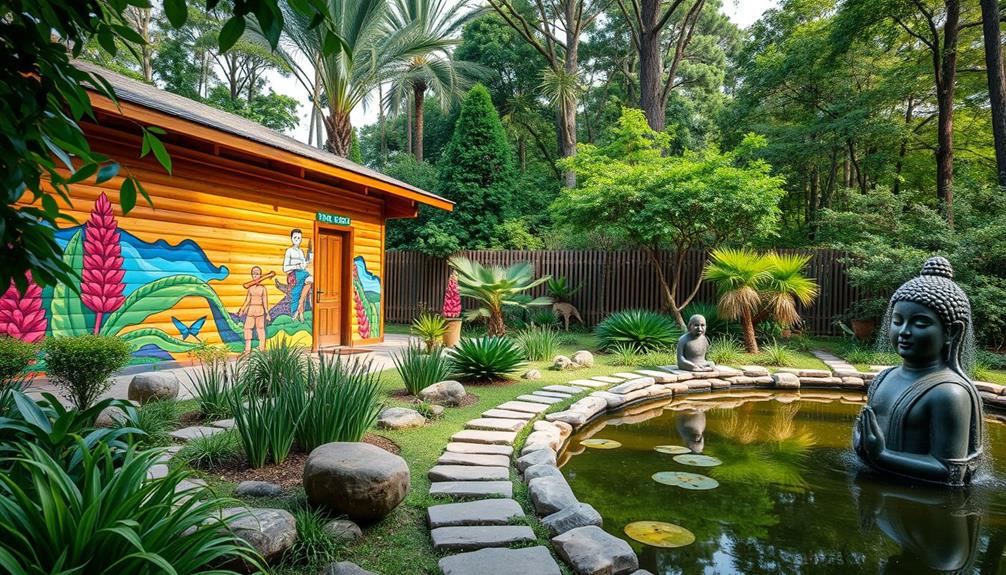
Incorporating art into retreat center design transforms the atmosphere, making it more inviting and inspiring for participants. By using local artwork and installations, you create a sense of place that enhances your connection to the surrounding environment and culture.
Imagine walking into a communal area adorned with vibrant murals or intriguing sculptures; these artistic elements foster creativity and encourage collaborative interactions among guests. This aligns with the idea of nurturing an imaginative mindset, as seen in the importance of art in creativity.
Natural light plays an essential role, too. When combined with artistic elements in architectural design, it improves psychological well-being, cultivating a serene atmosphere perfect for relaxation and reflection.
You'll find that spaces dedicated to art exhibitions allow a dialogue between creators and retreat participants, fostering community and shared purpose.
Additionally, integrating art therapy sessions into your retreat program provides a supportive environment for exploring creativity. It's often in these moments that personal breakthroughs and deeper artistic exploration occur, enriching your overall experience.
Art as a Community Connector
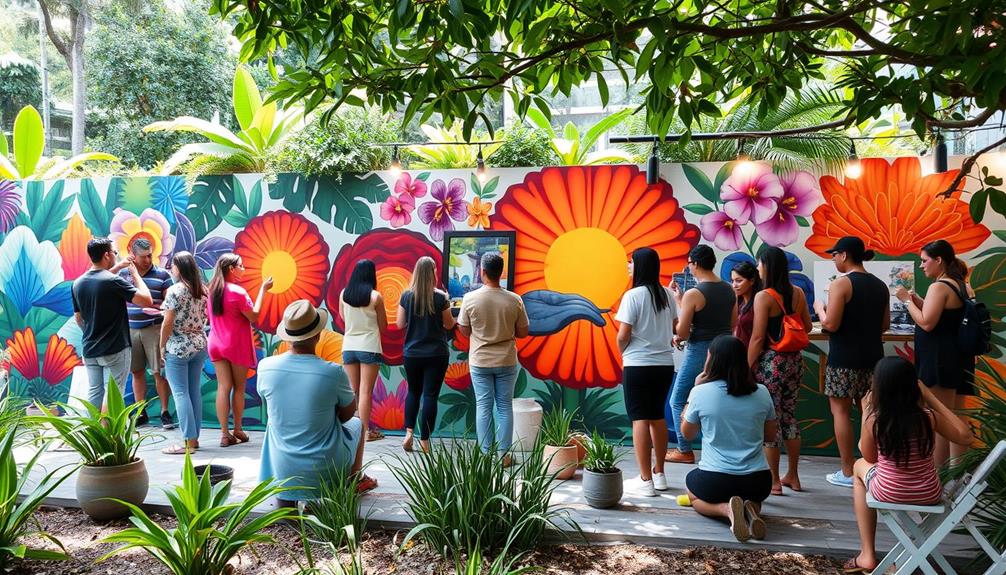
Art transforms retreat centers into collaborative creative spaces where you can connect with others.
By showcasing local artists and engaging in cultural exchange opportunities, these environments foster a sense of community and shared identity.
Incorporating elements of minimalism and decluttering can enhance the artistic atmosphere, allowing creativity to flourish in a serene setting.
You'll find that participating in group art activities not only strengthens bonds but also sparks meaningful conversations among diverse attendees.
Collaborative Creative Spaces
Creative spaces in retreat centers play a vital role in building a strong sense of community among artists. By incorporating collaborative creative spaces into their architectural design, these centers foster an environment where artists can share techniques, ideas, and experiences. This interaction enhances artistic growth and strengthens connections among participants.
| Benefits of Collaborative Spaces | Impact on Artists |
|---|---|
| Encourages idea sharing | Boosts creativity |
| Facilitates group projects | Enhances collaboration |
| Provides diverse tools | Supports various practices |
| Stimulates networking | Builds lasting relationships |
Retreat centers designed with communal studios and exhibition areas promote interaction, allowing you to engage in group discussions and projects that inspire fresh perspectives. Including natural elements and local cultural references in the architecture creates an inviting atmosphere, enhancing your connection to the environment. Art retreats that prioritize these collaborative spaces have been shown to increase productivity and satisfaction, making your time there even more fulfilling. By providing a variety of artistic tools and resources, retreat centers empower you to experiment and innovate collectively, ultimately enriching your artistic journey.
Cultural Exchange Opportunities
Engaging with local culture enriches the retreat experience, allowing you to connect with your surroundings on a deeper level.
Art retreats often incorporate local art and cultural elements, providing a vibrant platform for cultural exchange. By creating mood boards essential for visualizing these design concepts, participants can better appreciate the local aesthetic.
You'll find collaborative art projects serve as a bridge, fostering dialogue and mutual understanding among artists from diverse backgrounds.
When you participate in workshops led by local artists, you directly engage with the cultural heritage of the area. This hands-on experience helps you learn traditional techniques and practices, enriching your artistic journey.
Additionally, public exhibitions or installations created during retreats invite local residents to engage, creating a shared experience that celebrates artistic expression.
Designing Spaces for Creativity
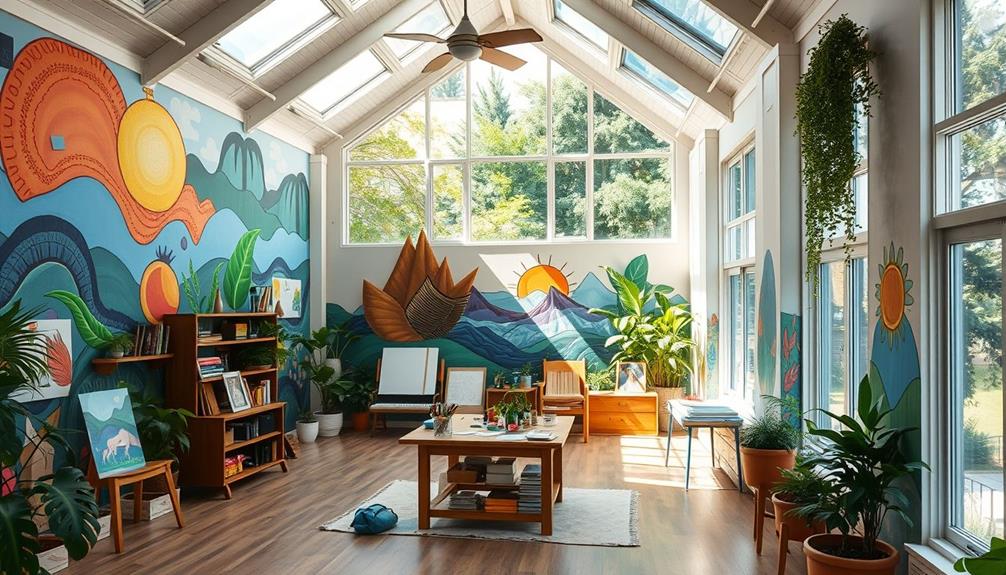
When you design spaces for creativity, think about how inspiring natural environments can spark new ideas.
Curiosity boosts mental health by fostering a positive mindset, which can be enhanced in thoughtfully designed spaces.
Balancing private areas for focused work with collaborative spaces encourages interaction among artists, fostering a vibrant creative community.
Inspiring Natural Environments
Many artistic retreat centers thrive in stunning natural environments that spark inspiration and tranquility. These settings are carefully chosen to leverage landscapes that stimulate creativity for individual artists.
Imagine waking up to breathtaking views, where every sunrise ignites your imagination and every rustle of leaves fuels your artistic passion. Incorporating elements like a DIY fire pit can enhance the outdoor experience, providing a cozy gathering space that fosters collaboration and connection among artists.
Architectural design plays a vital role in this connection, incorporating elements like natural light and open spaces. Such features not only enhance your psychological well-being but also create an atmosphere that encourages exploration and self-expression. Dedicated studios and exhibition spaces are seamlessly integrated with their surroundings, allowing you to focus deeply on your work while remaining connected to nature.
Sustainable materials and eco-friendly practices further enrich this experience, fostering a harmonious relationship between the built environment and the great outdoors. This thoughtful design minimizes environmental impact and inspires you to express your creativity in new ways.
Additionally, accessibility considerations guarantee that all artists, including those with health challenges, can fully engage in their creative processes, making these inspiring natural environments welcoming for everyone.
Collaborative Artistic Spaces
Creating collaborative artistic spaces is vital for fostering creativity and interaction among artists in retreat centers. These spaces should integrate studios, exhibition areas, and communal gathering spots, allowing for a dynamic exchange of ideas. Thoughtful architectural design plays a key role; incorporating natural surroundings and maximizing natural light can greatly enhance the artistic atmosphere, inspiring creativity.
Balancing private workspaces for focused exploration with communal areas for collaboration is essential. This dual approach cultivates a supportive artistic community, where artists can work independently while also engaging with others. Gathering feedback from artists about their unique needs during the design process guarantees that the spaces facilitate both creativity and comfort.
Furthermore, including diverse artistic mediums and activities in retreat programming enriches the creative experience, encouraging cross-disciplinary collaboration.
Here's a visual representation of these ideas:
| Space Type | Purpose |
|---|---|
| Studios | Focused artistic exploration |
| Exhibition Areas | Showcasing works and ideas |
| Communal Gathering Spots | Fostering interaction and collaboration |
Cultural Reflection in Art
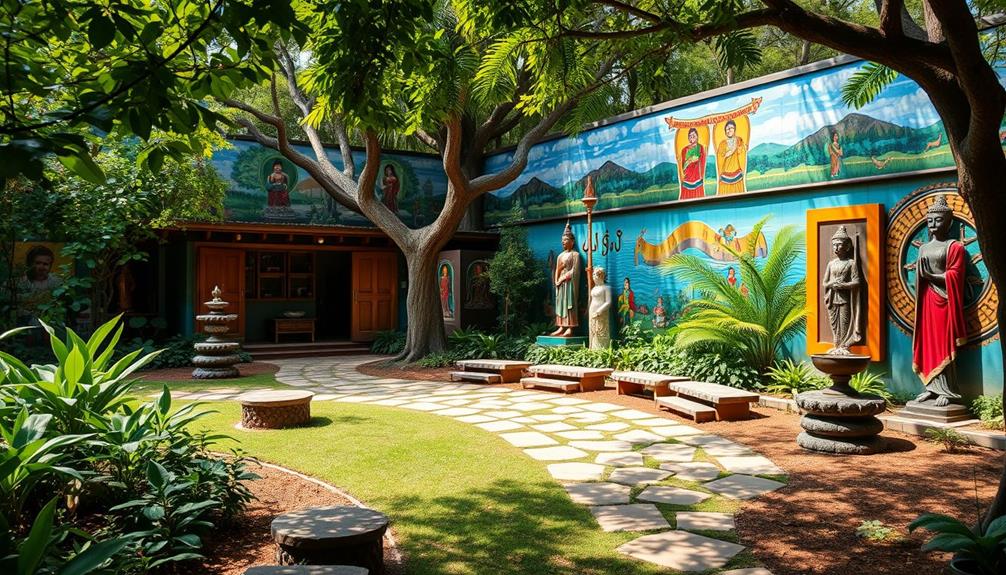
Throughout history, art has served as a mirror reflecting the cultural essence of its surroundings. In art retreats, you'll often find that they embody the local heritage, blending traditional artistic practices into their design and programming. This integration enhances your connection to the environment and deepens your experience.
For example, the incorporation of unique architectural styles, much like those found in ancient Hopi Tribe villages, can create a profound sense of place and cultural identity unique architectural styles.
Architecturally, these retreats can feature culturally significant elements, like traditional motifs and materials, which resonate with the local identity. This intentional design inspires creativity and provides you with an authentic atmosphere.
Community engagement in the planning process not only fosters a sense of belonging but also reflects the values and narratives of the local culture, enriching your artistic journey.
You might notice that artistic installations and outdoor spaces serve as canvases for local artists, promoting cultural expression and showcasing the unique characteristics of the surrounding landscape.
The atmosphere is carefully crafted to evoke the essence of local culture, utilizing color palettes, textures, and forms inspired by regional art and architecture. This immersive environment encourages you to explore your creativity while honoring the rich cultural reflection that art embodies in these retreats.
Accessibility Considerations in Art Spaces

Art retreats often fall short when it comes to accessibility, leaving individuals with health challenges feeling excluded.
To create truly inclusive spaces, it's crucial to prioritize accessibility needs from the outset. This inclusivity can greatly enhance participants' emotional and psychological growth, paralleling the key domains of development in psychology.
Here are some key considerations:
- Infrastructure: Verify that facilities are designed with ramps and wide pathways to accommodate mobility devices.
- Flexible Scheduling: Plan activities with ample breaks, allowing participants to recharge and manage their health effectively.
- Clear Communication: Promote accessibility features in your materials, so potential attendees know what to expect before they arrive.
- Engagement: Involve artists with disabilities in the planning stages. Their insights can help shape a more inclusive environment.
- Diverse Programming: Offer a range of artistic activities that cater to various skill levels and physical abilities.
The Impact of Natural Surroundings
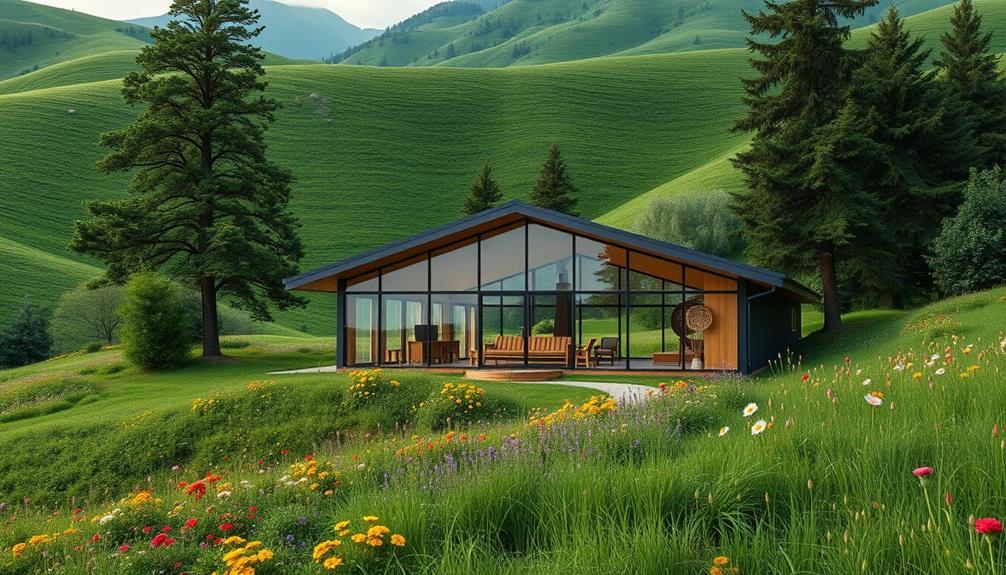
Natural surroundings can profoundly influence your creative process at an art retreat. Environments filled with beauty and tranquility stimulate your artistic expression and motivation. When you spend time in nature, you often find that your productivity increases and your artistic vision becomes clearer. This makes the location of an art retreat a vital consideration.
Incorporating relaxing elements such as water features can enhance the atmosphere, much like the thrilling adventures found in water parks that offer a revitalizing escape. Retreat centers that integrate natural elements, such as gardens, water features, and scenic views, greatly enhance your psychological well-being. You'll likely feel a sense of peace that allows your creativity to flourish.
Architectural designs that include features like floor-to-ceiling windows and open spaces create a seamless connection between indoors and outdoors, enriching your overall retreat experience.
Moreover, picturesque locations encourage networking and collaboration among artists. Shared experiences in natural surroundings lead to deeper connections and creative partnerships. When you're surrounded by beauty, it's easier to inspire and be inspired by others.
As you engage with nature, you reveal new perspectives that can deeply influence your artwork. Fundamentally, the impact of natural surroundings is essential for nurturing your creativity in an art retreat setting.
Innovative Art Installations
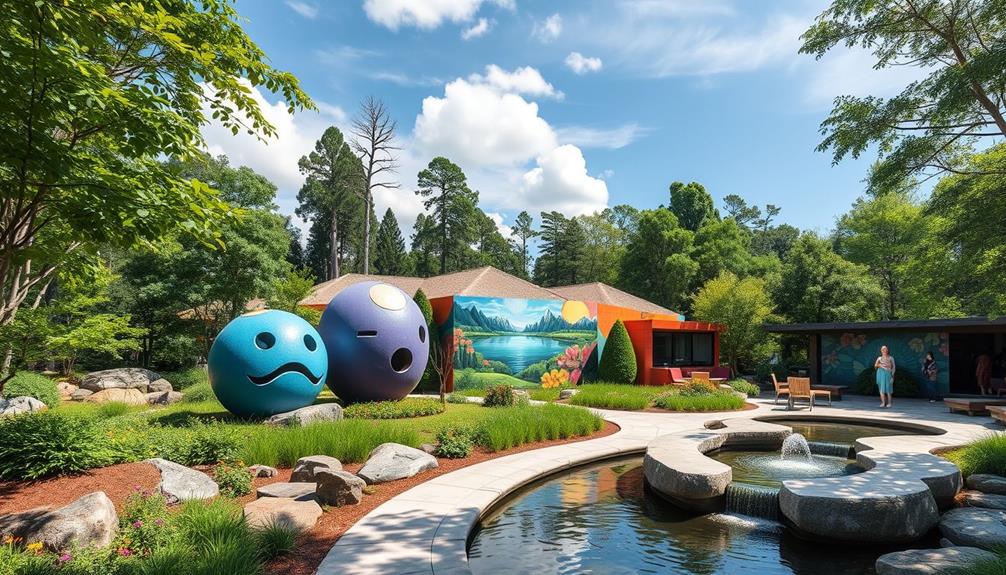
When you step into a retreat center designed with innovative art installations, you're immediately immersed in an environment that sparks creativity and reflection. These installations enhance the atmosphere, drawing you into unique experiences that engage your senses and inspire your imagination.
The incorporation of local artists' works not only fosters a sense of community but also mirrors the way luxury cruises provide exclusive amenities that elevate the travel experience. Whether you're in New York or elsewhere, the incorporation of local artists' works fosters a sense of community, connecting you to the surrounding culture.
Consider the impact of:
- Interactive installations that invite participation and collaboration.
- Dedicated studios or galleries showcasing artists' work.
- Sustainable art practices that highlight eco-consciousness.
- Collaborative murals that encourage social interaction.
- Sculpture gardens that blend nature with artistic expression.
These elements not only enrich your experience but also promote creative expression among retreat attendees.
Future Trends in Art Retreat Design

As the landscape of retreat center design evolves, future trends are shaping spaces that prioritize inclusivity and sustainability. You'll notice a strong emphasis on accessible facilities and flexible schedules, guaranteeing that everyone, regardless of health or mobility needs, can participate fully. This shift responds to the growing demand for equitable participation in artistic endeavors.
Many retreats are adopting a minimalist approach, creating serene environments that minimize distractions while still offering communal spaces for collaboration. These designs feature private creative areas, allowing you to immerse yourself in your work while still benefiting from the energy of fellow artists.
Hybrid models are also gaining traction, blending in-person experiences with virtual options. This flexibility caters to artists who might face health or logistical barriers, broadening the reach of retreats.
Additionally, architectural innovations, like biophilic design elements, connect indoor spaces with nature, fostering inspiration and creativity.
Sustainable practices are becoming essential too, with a focus on using eco-friendly materials and promoting local biodiversity.
Embracing these trends guarantees that future art retreats not only nurture creativity but also reflect a commitment to inclusivity and environmental responsibility.
Frequently Asked Questions
What Is the Role of the Art Center?
The art center's role is to inspire creativity and foster collaboration. You'll find spaces for artistic exploration and relaxation, allowing you to connect with others, express yourself, and immerse in a nurturing environment.
Why Is Atmosphere Important in Art?
Atmosphere's essential in art—without it, inspiration vanishes like a fleeting dream! You'll find that a vibrant, harmonious space ignites your creativity, fueling your passion and transforming your artistic journey into something truly extraordinary.
What Is the Role of Art in the Community Building?
Art fosters connections within a community, encouraging collaboration and shared experiences. By engaging in creative projects together, you strengthen relationships, promote understanding, and create a vibrant environment that reflects collective values and identities.
What Is the Role of Art in Addressing Environmental Issues?
Art inspires awareness, provokes dialogue, and sparks action regarding environmental issues. It transforms complex data into emotional narratives, engages communities in sustainability discussions, and encourages critical thinking, helping you connect deeply with pressing ecological challenges.
Conclusion
Art transforms retreat centers into enchanted sanctuaries where creativity dances and inspiration flows like a river of light. Imagine stepping into a space where every brushstroke whispers secrets of connection and every sculpture invites you to explore new dimensions of thought. This vibrant tapestry of artistic expression weaves together the beauty of nature and community, creating an atmosphere so alive, it feels like the walls themselves are breathing. Embrace the magic of art, and let your spirit soar!
- About the Author
- Latest Posts
Introducing Ron, the home decor aficionado at ByRetreat, whose passion for creating beautiful and inviting spaces is at the heart of his work. With his deep knowledge of home decor and his innate sense of style, Ron brings a wealth of expertise and a keen eye for detail to the ByRetreat team.
Ron’s love for home decor goes beyond aesthetics; he understands that our surroundings play a significant role in our overall well-being and productivity. With this in mind, Ron is dedicated to transforming remote workspaces into havens of comfort, functionality, and beauty.
Retreat
Creating a Sensory Garden for Mindfulness and Healing
Pave your way to tranquility by designing a sensory garden that nurtures mindfulness and healing; discover how to create your own serene oasis.

Creating a sensory garden helps you connect with nature while promoting mindfulness and healing. Start by incorporating diverse plants that engage all five senses. Vibrant flowers and unique textures can visually stimulate you, while aromatic herbs offer calming fragrances. Add soothing water features to enhance auditory experiences and create a peaceful ambiance. Design distinct sensory zones for exploration and reflection, ensuring pathways are accessible. Incorporating seating areas encourages relaxation, making it a perfect retreat. This garden not only reduces stress but also fosters emotional well-being, inviting you to immerse yourself fully in this therapeutic environment. Explore further to uncover more ideas.
Key Takeaways
- Design distinct sensory zones to engage all five senses and enhance mindfulness experiences in the garden.
- Incorporate diverse plants with vibrant colors, textures, and fragrances to foster emotional well-being and relaxation.
- Utilize water features like fountains and ponds to create soothing sounds and attract wildlife, enhancing the sensory experience.
- Create comfortable seating areas and private nooks for reflection and contemplation, promoting a calming atmosphere.
- Include edible plants to connect gardening with culinary enjoyment, encouraging engagement and mindfulness through taste.
The Importance of Sensory Gardens

In today's fast-paced world, sensory gardens play an essential role in fostering mindfulness and emotional well-being. These carefully designed spaces engage your senses, offering a unique opportunity to connect with nature while promoting healing.
By incorporating a variety of plants with different textures, colors, and fragrances, you can create an immersive environment that not only captivates your senses but also encourages relaxation. Additionally, sensory gardens can be particularly beneficial for individuals experiencing emotional dysregulation, as they provide a calming space that aids in grounding and self-soothing, which is vital for those with challenges like BPD dynamics in relationships.
Studies show that spending time in sensory gardens can considerably reduce stress and anxiety levels. As you explore the garden, the sights and smells of the plants can ground you in the moment, enhancing your mindfulness practice. This connection to nature can be especially beneficial for individuals with conditions like dementia and autism, providing a calming atmosphere that enhances their sensory experiences.
Additionally, sensory gardens foster community involvement, allowing you to engage with others who share similar interests. This sense of belonging can further contribute to emotional healing.
Engaging All Five Senses

In a sensory garden, you'll want to use vibrant flowers and diverse plant shapes to captivate your sense of sight.
Incorporating fragrant herbs like lavender and peppermint can further engage your sense of smell, enhancing the overall experience while promoting relaxation and tranquility through essential oils for respiratory health.
By incorporating a variety of textures, you can enhance tactile engagement, inviting you to explore the unique feel of each plant.
Together, these elements create a rich environment that engages your senses and fosters mindfulness.
Visual Stimulation Techniques
Visual stimulation techniques in a sensory garden can transform your experience, engaging all five senses in a harmonious way. By thoughtfully incorporating visual stimuli, you create a rich sensory experience that can reduce anxiety and enhance your sense of well-being.
Contemplate using unique planter designs that incorporate artistic elements to enhance your garden's visual appeal. Here are three effective strategies to contemplate:
- Diverse Plant Selection: Use vibrant flowers like purple coneflower and tulips to attract pollinators. The variety in colors, shapes, and textures evokes emotional responses, improving your mood and fostering a deeper connection to the garden.
- Distinct Sensory Zones: Create areas dedicated to different senses, such as sight, smell, and taste. This organization allows you to immerse yourself in the garden, experiencing each zone's unique offerings while encouraging exploration.
- Water Features and Foliage: Incorporate water elements for visual appeal and soothing sounds. Pair these with ornamental grasses and striking foliage to add drama. This combination enhances visual interest, making the garden even more inviting.
Tactile Engagement Strategies
Tactile engagement in a sensory garden brings a world of textures to your fingertips, inviting you to explore and connect with nature on a deeper level. By incorporating a variety of plant textures like soft lamb's ears and rough tree bark, you stimulate your sense of touch, encouraging mindful exploration.
Pathways made from smooth pebbles or coarse gravel provide contrasting tactile experiences as you navigate through the garden. Engaging with tactile plants such as aloes and agaves lets you experience sensations that promote mindfulness and a stronger connection to your surroundings.
Utilizing elevated raised beds enhances accessibility, inviting everyone to comfortably interact with plants at the perfect height. Regular touch, like feeling the soil's texture or the softness of petals, fosters awareness and cultivates calm.
Here's a quick look at how tactile engagement can enhance your sensory garden experience:
| Element | Emotional Connection |
|---|---|
| Soft lamb's ears | Comfort and warmth |
| Rough tree bark | Stability and grounding |
| Smooth pebbles | Serenity and peace |
| Coarse gravel | Adventure and discovery |
| Aloe and agave textures | Curiosity and wonder |
Embrace these elements to create a healing space!
Designing Your Garden Layout
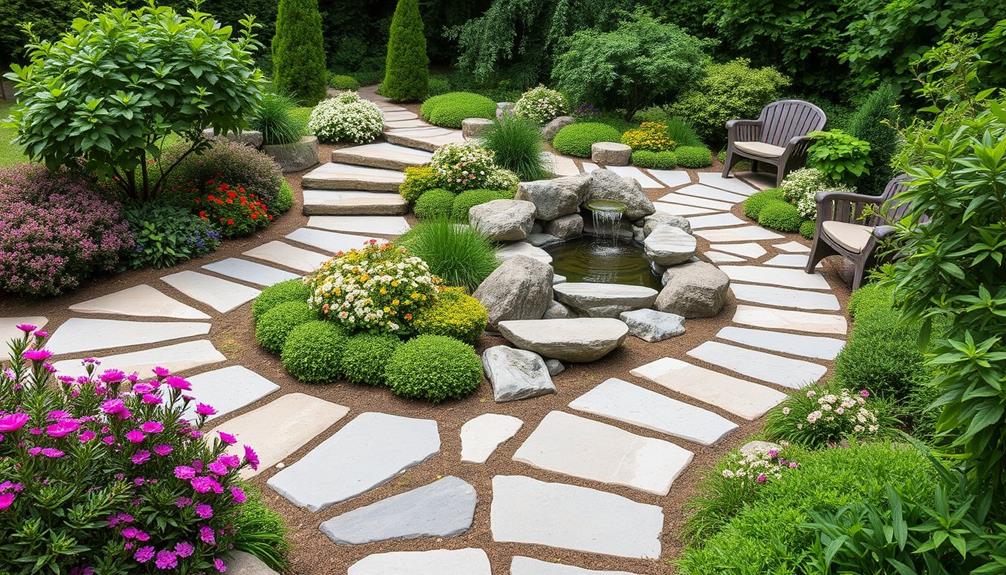
When designing your sensory garden layout, start by creating distinct zones that cater to each of the five senses.
This approach not only enriches the sensory experience but also encourages curiosity and happiness as visitors engage with various elements.
Consider how pathways will guide visitors through these areas while ensuring they're accessible for everyone.
This thoughtful arrangement not only enhances engagement but also fosters a more inclusive experience.
Sense Zones Arrangement
Creating your sensory garden layout involves thoughtfully arranging distinct sense zones that invite exploration and engagement. By dividing your outdoor space into areas that stimulate multiple senses, each zone can offer a unique experience.
Consider these three essential elements:
- Visual Appeal: Use diverse plant types and varying heights to create visual interest. Incorporate vibrant flowers, lush greenery, and textured plants to captivate the eyes. Adding elements such as DIY fire pit ideas can also enhance the overall ambiance and visual allure of your garden.
- Auditory Features: Enhance sound experiences with water features, like fountains or small ponds, and gravel pathways that crunch underfoot. These elements add soothing sounds that promote relaxation.
- Interactive Spaces: Designate areas for touch and taste, such as herb gardens or tactile plants. Include seating areas for reflection, allowing you to engage fully with your sensory garden.
Ensure that each sense zone connects seamlessly, encouraging your exploration.
Pathways and Accessibility
Your sensory garden's layout can greatly benefit from well-planned pathways that assure smooth navigation and accessibility for everyone, including those with mobility challenges.
Start by designing wide, even pathways that make it easy for wheelchairs or walkers to traverse. Consider using diverse pathway materials like gravel or pavers to create contrasting textures that engage the sense of touch while guiding visitors through various sensory zones.
Additionally, make certain that your garden design incorporates safety features to protect seniors from potential hazards, as protecting seniors from financial scams can also apply to their physical environments.
Incorporate elevated raised beds to guarantee easy access to plants for individuals with limited reach or strength. This encourages interaction with the garden, fostering a deeper connection to nature.
Plan for seating areas along the pathways, allowing visitors to take a break and fully enjoy the surrounding sensory experiences. These spots can enhance mindfulness practice, providing moments of reflection amid the vibrant environment.
Strategically place plants with strong scents or vibrant colors near pathways and seating areas to attract attention and promote relaxation.
Plant Selection for Sensory Impact
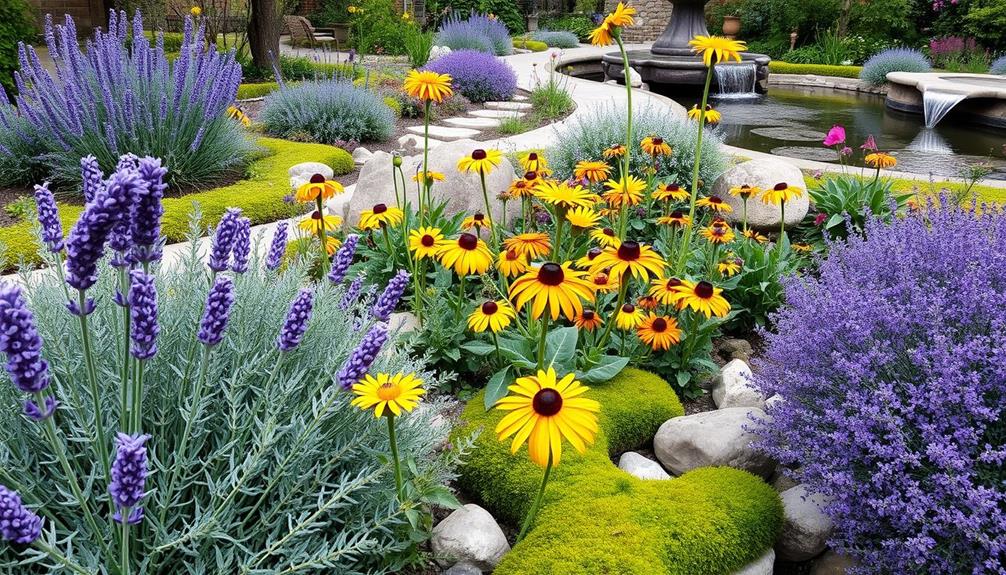
Selecting the right plants for a sensory garden can transform it into a vibrant oasis that engages all five senses. To create this immersive experience, you'll want to choose plants that stimulate sight, smell, touch, taste, and sound. Incorporating elements from nature can also enhance the overall well-being of the garden space, similar to how proper diet includes fresh fruits for pets affects their health.
- Sight: Pick vibrant flowers like echinacea and marigolds. Their bright colors and diverse shapes will catch the eye and bring joy to your garden.
- Smell: Incorporate aromatic herbs such as lavender and rosemary. These not only provide delightful garden scents but also evoke calmness through their soothing fragrances.
- Touch: Choose plants with varying textures. Lamb's ears with their soft leaves and the rough bark of certain trees enhance tactile experiences, inviting exploration.
Don't forget to include edible plants like strawberries and mint to engage taste, fostering a connection between gardening and culinary enjoyment.
Finally, select plants that attract wildlife, like coneflowers and bee balm, enriching your garden's auditory experience with the sounds of buzzing bees and chirping birds.
Incorporating Water Features

Water features play a significant role in enhancing the sensory experience of a garden. Incorporating elements like fountains or ponds creates soothing sounds that promote relaxation and mindfulness. These water features not only enrich the auditory experience but also attract wildlife, adding to your garden's ecosystem. Imagine the gentle splashing of water, inviting birds and beneficial insects to visit.
| Water Feature Type | Benefits |
|---|---|
| Fountains | Creates soothing sounds |
| Ponds | Attracts wildlife |
| Reflective surfaces | Enhances visual appeal |
Reflective surfaces of water features provide a calming effect through the interplay of light and water, inviting contemplation. The tactile engagement of splashing water or the coolness of submerged plants deepens your sensory interaction with the environment. Research shows that the presence of water in natural settings can lower stress levels and improve mood. This makes water features essential components of therapeutic gardens designed for healing and mindfulness. By incorporating these elements, you create a tranquil oasis that nurtures both the mind and the spirit, allowing you to fully embrace the benefits of your sensory garden.
Creating Comfortable Spaces
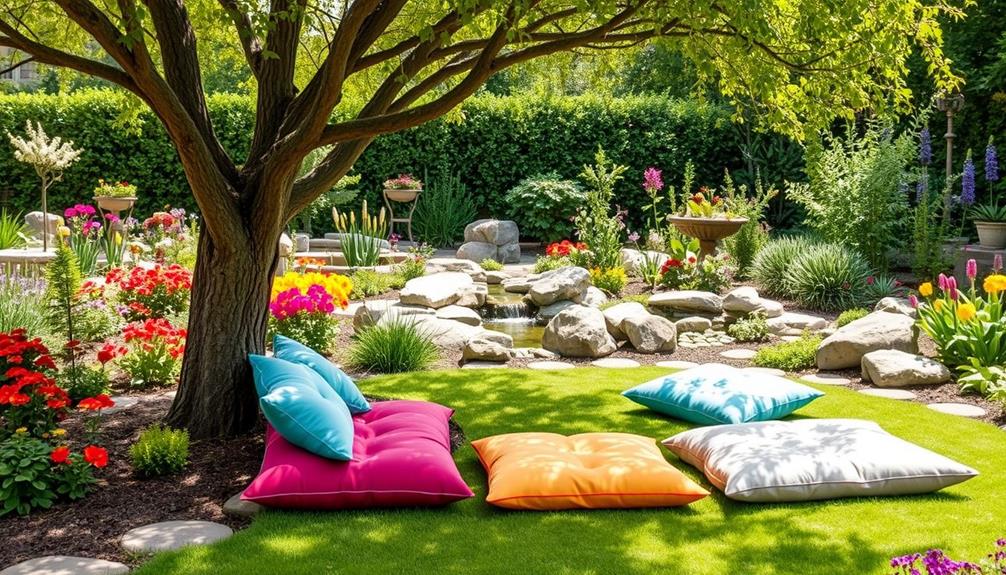
In the heart of your sensory garden, creating comfortable spaces is essential for fostering mindfulness and reflection. By incorporating carefully designed areas, you can invite visitors to relax and engage with the garden's sensory experiences.
Contemplate integrating elements that promote emotional well-being, similar to how natural remedies alongside conventional medications can enhance overall health. Here are three key elements to contemplate:
- Comfortable Seating: Use benches or hammocks to encourage visitors to settle in and take in the sights and sounds around them. This enhances mindfulness and reflection.
- Private Nooks: Design secluded spots with taller plants to provide privacy and a sense of safety. These intimate areas invite individuals to immerse themselves in the calming atmosphere of the garden.
- Sensory Appeal: Position fragrant herbs and vibrant flowers near seating areas to stimulate and appeal to multiple senses. This promotes relaxation, encouraging users to linger longer in the space.
Benefits for Mental Wellbeing

A vibrant array of colors and scents in a sensory garden can work wonders for your mental wellbeing. Engaging with these spaces markedly reduces anxiety levels and promotes relaxation, which is vital for maintaining emotional health.
By incorporating elements that enhance creativity, like those found in the power of imagination, you can further enrich your experience. Spending time surrounded by nature allows you to lower cortisol levels, leading to improved cognitive function and a heightened sense of calmness.
The multi-sensory experiences offered by sensory gardens enhance mindfulness, allowing you to focus on the present moment and reduce stress effectively. As you immerse yourself in this environment, you might find that it evokes positive memories and emotions, especially beneficial for those with conditions like dementia or autism.
Regular interaction with sensory gardens encourages resilience and improved coping skills, which are fundamental for overall mental clarity and emotional stability.
You'll likely discover that the simple act of tending to plants or enjoying their beauty provides a therapeutic outlet, helping you navigate the challenges of daily life with greater ease. Ultimately, incorporating a sensory garden into your routine can be a profound step towards nurturing your mental wellbeing and enhancing your emotional health.
Frequently Asked Questions
How Do You Make a Sensory Garden?
To make a sensory garden, start by planning distinct zones for each sense. Choose vibrant plants, add sound features, guarantee accessibility, and maintain it regularly. This'll help create a rich, immersive experience you can enjoy.
How Do You Make a Mindful Garden?
To make a mindful garden, choose plants that engage your senses, create quiet spaces for reflection, and incorporate paths that invite exploration. Surround yourself with nature's beauty, allowing it to foster peace and connection.
How Do You Create a Healing Garden?
To create a healing garden, think of it as a symphony where each element plays a role. You'll blend varied plants, soothing sounds, and inviting spaces, fostering tranquility and connection with nature for everyone.
How Does a Sensory Garden Work?
A sensory garden works by engaging your senses with diverse plants and elements. You'll touch different textures, smell fragrant flowers, and hear soothing sounds, enhancing relaxation and fostering a deeper connection to nature and your emotions.
Conclusion
Creating a sensory garden can be a transformative experience for your mental wellbeing. Did you know that spending just 20 minutes a day in nature can greatly reduce stress levels? By engaging all five senses, designing a thoughtful layout, and incorporating elements like water features and comfortable spaces, you can cultivate a serene environment that promotes mindfulness and healing. So, why not start planning your sensory garden today? Your mind—and body—will thank you!
- About the Author
- Latest Posts
Introducing Ron, the home decor aficionado at ByRetreat, whose passion for creating beautiful and inviting spaces is at the heart of his work. With his deep knowledge of home decor and his innate sense of style, Ron brings a wealth of expertise and a keen eye for detail to the ByRetreat team.
Ron’s love for home decor goes beyond aesthetics; he understands that our surroundings play a significant role in our overall well-being and productivity. With this in mind, Ron is dedicated to transforming remote workspaces into havens of comfort, functionality, and beauty.
-
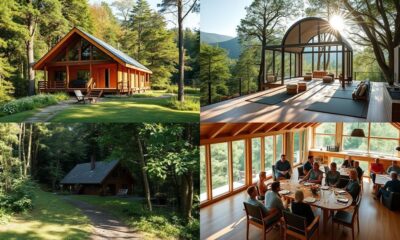
 Retreat4 weeks ago
Retreat4 weeks agoThe Pros and Cons of Different Retreat Center Business Models
-
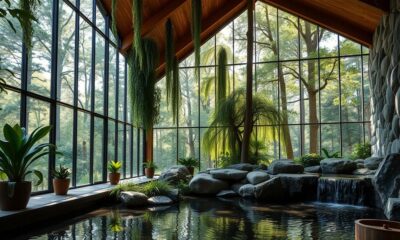
 Retreat2 weeks ago
Retreat2 weeks agoIncorporating Biophilic Design in Your Retreat Center
-
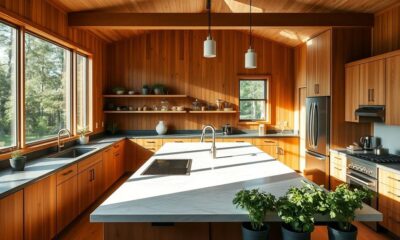
 Retreat2 weeks ago
Retreat2 weeks agoDesigning a Retreat Center Kitchen: From Layout to Equipment
-

 Southeast Asia Decor4 weeks ago
Southeast Asia Decor4 weeks ago10 Tips for Feng Shui in Local Interiors
-

 Southeast Asia Decor3 weeks ago
Southeast Asia Decor3 weeks agoHistorical Feng Shui Color Schemes in Interiors
-

 Southeast Asia Decor4 weeks ago
Southeast Asia Decor4 weeks agoBatik: Cultural Symbolism in Modern Interior Design
-

 Southeast Asia Decor3 weeks ago
Southeast Asia Decor3 weeks agoFeng Shui Color Palettes for Your Home
-
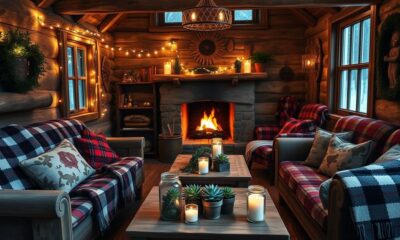
 Retreat2 weeks ago
Retreat2 weeks agoDIY Rustic Decor Ideas for a Cozy Retreat Atmosphere









